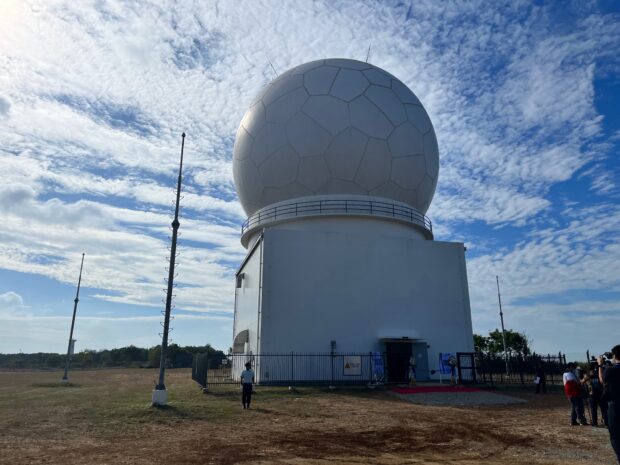PAF acquires sharper eye for threats in WPS

FIRST OF FOUR DELIVERIES The J/FPS-3ME warning and control radar system from Mitsubishi Electric Corp. of Japan is formally turned over on Wednesday to the Philippine Air Force, which is putting the new technology to use at Wallace Air Station in San Fernando City, La Union province. —FRANCES MANGOSING
SAN FERNANDO CITY, LA UNION — Resting on a base like a massive golf ball ready for tee-off, it is the country’s latest and most modern detection system for any aerial or naval threat coming from the West Philippine Sea (WPS).
Located at a Philippine Air Force (PAF) base here, the Japanese-built air surveillance radar system was formally turned over to the PAF in simple ceremonies held on Wednesday.
The Wallace Air Station, a former US air base, has been without any capability to detect intrusions since 2015 after it retired its US-made air surveillance radars that had been in use since the 1950s.
The PAF formally received the J/FPS-3ME warning and control radar system built by Mitsubishi Electric Corp. It is the first of four long-range surveillance radars—three of them fixed and one in a mobile setup—ordered by the Department of National Defense in 2020 under a P5.5-billion government-to-government deal.
The deal marked the first time Japan had secured a contract to export military hardware, a few years after it ended decades of a self-imposed ban on arms exports in 2014.
For quicker response
“This radar, which will operate as part of our integrated air defense system, will enable us to detect potential threats from greater distances with increased precision, giving us quicker response times to intercept,” PAF chief Lt. Gen. Stephen Parreño said in a speech.
“With over 7,000 islands to guard, the PAF needs the radar system to keep watch of the entire archipelago with greater accuracy and efficiency. This becomes especially crucial given the evolving security landscape in the region,” he added.
The system has a range of up to 556 kilometers (300 nautical miles) for air targets and more than 926 km (500 nautical miles) for ballistic missiles.
The package includes radar support facilities. A command and control building located a few meters away from the radar tower was also inaugurated on Wednesday.
The next three radar systems are expected to be delivered in the next two years.
‘Serious concern’
“The transfer of the radar system means the Philippines has a new eye toward its surrounding airspace with Japanese made equipment, solidifying the evidence of our cooperation and contributing to peace and stability in the region,” Osamu Nishiwaki, assistant commissioner of Japan’s Ministry of Defense Acquisition, Technology and Logistics Agency, said during the program.
Nishiwaki pledged Tokyo’s continued support for the country’s military buildup as he reiterated Japan’s serious concern over China’s aggressive behavior toward Philippine vessels in the West Philippine Sea.
“Japan knows that there are frequent reports of obstructive actions to Philippine ships by the Chinese ships, including the China Coast Guard. Japan reiterates serious concern over such actions which increase regional tensions,” he added.
Defense Secretary Gilberto Teodoro Jr. said the PAF upgrade was “one of the concrete steps and actions that our strategic partner Japan has done in order to firm up our alliance.”
Japan, he said, has unequivocally supported the 2016 South China Sea arbitral award in favor of the Philippines.
‘Shared values’
“We are cooperating (with them) because we have shared values against the contrived and unilateral attempt by other countries to appropriate an international body of water called the South China Sea and worse, parts of the exclusive economic zone of the Philippines which we call the West Philippine Sea, as its own, under convoluted and contrived legal arguments,” Teodoro said, without referring to China by name.
“This we cannot stand, and we are glad that other countries are supporting us,” he said.
During the visit of Japanese Prime Minister Fumio Kishida to Manila in November, the Philippines and Japan agreed to start talks on a reciprocal access agreement that would give Japanese troops greater access to Philippine bases.
Japan also pledged to provide a $4-million coastal radar surveillance system, this time to the Philippine Navy, under Tokyo’s new official security assistance program.
READ: PAF unveils newest air surveillance system near West Philippine Sea
